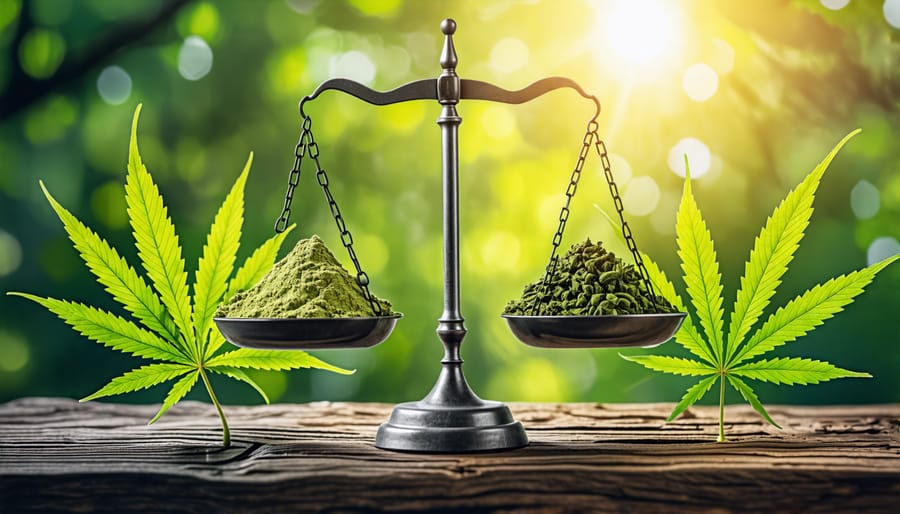Explore the differences between kratom and cannabis to make an informed choice by considering both benefits and risks. Assess the effects of each: kratom offers stimulating and sedative effects, while cannabis provides relaxation and potential pain relief. Understand medical uses—train wreck kratom presents a unique blend worth exploring. Kratom is often used for pain management and increasing energy, whereas cannabis is common for anxiety relief and improving sleep. Identify potential side effects: kratom can lead to dependency and gastrointestinal issues, while cannabis might cause dizziness or anxiety. Evaluate user experiences and expert insights to weigh the suitable option for your needs.
Understanding Kratom
The Origins of Kratom
Originating from the dense, humid jungles of Southeast Asia, Kratom is derived from the leaves of the Mitragyna speciosa tree. For centuries, this botanical wonder has been intertwined with the cultural practices of countries like Thailand, Indonesia, Malaysia, and Myanmar. Traditionally, local communities have relied on Kratom for its stimulating and sedative properties. Farmers and laborers often chewed its leaves or brewed the ground leaf powder into teas to boost energy and endurance during long, exhausting days. Additionally, in the evenings, small doses of Kratom have been used to unwind after a hard day’s work, acting as a natural relaxant. In these regions, Kratom has also played a role in folk medicine, addressing ailments such as discomfort from physical pain and stomach disorders. Its rich history and deep cultural roots in Southeast Asia showcase its diverse applications and the integral role it has held in traditional practices for generations.

Kratom in Modern Medicine
Kratom, derived from the leaves of a tropical tree native to Southeast Asia, is gaining traction as a natural alternative in modern medicine. Known primarily for its potential in pain management and alleviating symptoms of anxiety and depression, many individuals turn to kratom for its purported therapeutic benefits. It’s often used by those seeking a holistic approach to managing chronic pain or wanting to reduce dependence on opioids. Despite these benefits, the legality of kratom varies significantly across the globe. In the United States, its status is somewhat contentious, with some states banning it while others allow its sale and usage. Meanwhile, countries like Thailand and Malaysia, where kratom naturally thrives, have complex regulations, reflecting ongoing debates about its safety and effectiveness. As people explore natural wellness remedies, kratom continues to be a topic of interest and study, underscoring the need for informed choices in natural health solutions.
Exploring Cannabis

Historical Use of Cannabis
Cannabis has a long-standing history as both a medicinal remedy and a cultural cornerstone. Ancient civilizations, including the Chinese and Egyptians, recognized its therapeutic potential centuries ago. In traditional Chinese medicine, cannabis was used as an anesthetic and to alleviate various ailments. Meanwhile, ancient Egyptians documented its use for treating inflammation and glaucoma.
Cannabis also played a significant part in Ayurveda, the traditional Indian system of medicine, revered for its ability to promote digestion and aid sleep. Beyond medicinal uses, it held spiritual significance in several cultures. For example, in Hindu rituals, cannabis was often consumed to enhance spiritual experiences and foster a sense of connection to the divine.
This historical use highlights cannabis as more than just a means of recreation; it was an integral component of traditional healing practices. Today, as more people explore natural alternatives to conventional treatments, understanding cannabis’s medicinal heritage becomes increasingly relevant.
Cannabis in Today’s World
Cannabis has become an important part of modern wellness and healthcare discussions due to its versatile applications and evolving legal status. Many individuals are turning to cannabis for its potential medicinal benefits of cannabis, seeking relief from conditions like chronic pain, anxiety, and epilepsy. With an increasing number of countries and states legalizing its use, both medicinal and recreational cannabis is more accessible than ever.
Legalization has not only increased availability but has also spurred research into cannabis’s therapeutic possibilities. This newfound legitimacy helps dispel outdated stigmas, encouraging users to share their positive experiences. Take Lisa, for instance, a long-time advocate whose personal testimony underscores cannabis’s role in managing her anxiety, enhancing her quality of life without the unwanted side effects of pharmaceuticals.
However, the legal landscape remains complex, with regulations varying regionally. Users should stay informed about local laws and ensure any use aligns with legal standards. As more research emerges, the understanding of cannabis continues to grow, offering both seasoned and new users opportunities to explore its benefits safely and legally.

Comparative Benefits and Risks
Health Benefits
Kratom and cannabis are often compared for their potential health benefits, each offering unique advantages. Kratom, a tropical plant indigenous to Southeast Asia, is often praised for its pain-relieving and mood-enhancing properties. Many users report that kratom helps manage chronic pain, reduce anxiety, and improve focus. Its ability to act as both a stimulant and a sedative, depending on the dosage, makes it an appealing natural alternative for those seeking relief from various ailments.
Cannabis, on the other hand, is widely recognized for its role in relieving symptoms associated with conditions like chronic pain, anxiety, and certain neurological disorders. The plant’s active compounds, such as CBD and THC, interact with the body’s endocannabinoid system to potentially reduce inflammation and alleviate discomfort. For those interested in understanding how cannabis affects the body, a closer examination of the science of THC can provide deeper insights. Medical cannabis patients often share testimonials of improved quality of life and symptom management, underscoring its value as a natural therapeutic option. Both kratom and cannabis offer promising health benefits, representing diverse alternatives for individuals seeking natural remedies.
Potential Risks and Concerns
When considering natural alternatives like Kratom and Cannabis, it’s crucial to be aware of the potential risks and concerns associated with their use. For Kratom, users report side effects ranging from nausea and constipation to more serious concerns like dependency and withdrawal symptoms. Long-term use may lead to health issues, and the FDA has raised concerns about its safety due to reports of contaminants and inconsistent potencies.
Cannabis, while often touted for its therapeutic benefits, is not without risks. Some individuals may experience unwanted side effects such as dry mouth, dizziness, or paranoia. More significant issues like dependency can develop with regular, heavy use, especially in individuals with a predisposed risk for addiction. Cognitive effects are also a consideration, as high THC levels might impact memory and concentration. For a deeper understanding of these effects, it’s worth exploring the research behind twin studies which investigate the relationship between cannabis use and cognitive decline.
It’s essential for users to weigh these risks against potential benefits and to consult healthcare professionals when considering either substance for therapeutic purposes. Prioritizing safe, informed usage and staying updated on research can help individuals make the best choices for their health and well-being.
Personalizing Your Choice
Lifestyle and Needs Assessment
Choosing between kratom and cannabis requires a thoughtful evaluation of your lifestyle and personal needs. Begin by considering what you’re seeking from these natural alternatives. Are you looking for pain management, stress relief, or enhanced well-being? Cannabis, with its varied strains, might offer relaxation and pain alleviation, while kratom is noted for its potential to boost energy and mood. Next, think about your routine. If discretion and convenience are priorities, there are different forms and methods of use for both substances. Additionally, assess your comfort level with potential side effects; cannabis may cause psychoactive effects, whereas kratom’s impact on opioid receptors should be considered. Seeking advice from health professionals or consulting with experienced users can also provide valuable insights, ensuring your choice aligns with your lifestyle and wellness goals.
Considering Legal and Social Factors
When considering natural alternatives like kratom and cannabis, it’s crucial to understand both legal restrictions and social perceptions. While the legalization of cannabis in many areas has made it more accessible, kratom remains subject to varying regulations worldwide. These legal landscapes can influence both availability and public perception. Cannabis is often associated with medicinal benefits and recreational use, which can carry stigmas or acceptance depending on one’s location. Kratom, while praised by some for pain relief and energy boosts, faces more skepticism due to its lesser-known status and inconsistent legality. Educating oneself on these factors is essential for making informed decisions and advocating for responsible use in accordance with local laws. Understanding these dynamics helps users navigate the nuances of public opinion and legal frameworks surrounding these substances.
Conclusion
As we conclude our exploration of Kratom and Cannabis, it’s clear that both offer intriguing natural alternatives for those seeking relief and wellness. Kratom, with its unique alkaloids, presents potential benefits for pain management and mood enhancement, though its legal status and side effects are factors to consider. Meanwhile, Cannabis continues to shine with its well-documented benefits for a range of conditions, from chronic pain to anxiety, supported by growing research and broader legalization.
Understanding the differences between these two can guide individuals in making informed decisions. Expert insights reveal that while some users find Kratom beneficial for its energizing effects, others lean towards Cannabis for its extensive therapeutic applications. Testimonials from users highlight personal journeys, illustrating the diverse impacts these substances can have.
It’s essential to weigh both the advantages and potential risks of Kratom and Cannabis, consult with healthcare professionals, and make choices aligned with personal health goals. In doing so, individuals can harness the natural power of these alternatives thoughtfully and safely.




